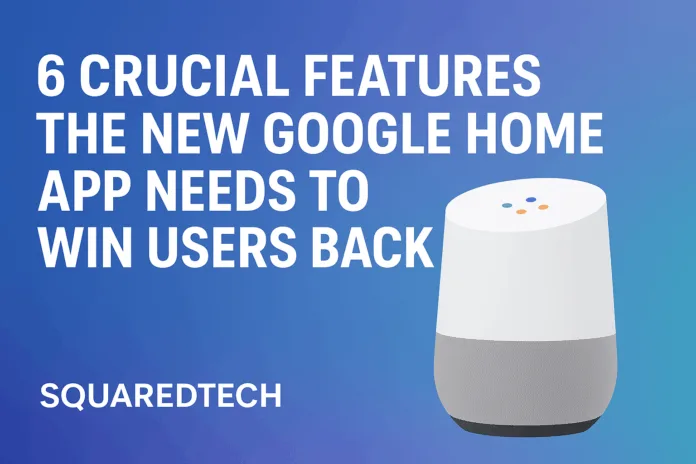Table of Contents
Why Google Home Still Feels Incomplete
At Squaredtech, we test smart home platforms every day, and we know that small design choices can make or break the user experience. The latest refresh of the Home app introduces a new interface, reorganized tabs, and most notably, Gemini integration. A permanent “Ask Home” text box now lets users query devices, check camera feeds, and request automation help directly through it.
This sounds exciting, but it does not solve Home’s long-standing limitations. The redesign looks fresh but still lacks the practical flexibility, automation depth, and device transparency that advanced users expect.
Based on our analysis and community feedback, here are the six crucial features that must be addressed if the Home app is to remain competitive.
Read More About Our Article of Google’s New Developer Verification for Sideloaded Android Apps Will Change Everything Published on August 30, 2025 SquaredTech
1. Customizable Tiles and a Smarter Dashboard
Home Assistant has proven how much flexibility matters. Users can fully customize dashboards, hide unnecessary devices, resize widgets, and prioritize information. By contrast, the dashboard has been static for years.
What’s missing in Home:
- ✅ Hide devices from view (such as motion sensors used only in routines).
- ✅ Resizable tiles that expand or shrink depending on activity.
- ✅ Richer data display on tiles (e.g., showing air quality without extra clicks).
- ✅ Custom tap actions for faster control.
Without these features, the dashboard feels cluttered and inefficient, making daily interaction with smart devices frustrating.
Automations should be the heart of a smart home app, but Google’s current system feels incomplete. The YAML editor offers advanced control, but it is too technical for everyday users.
Key limitations today:
- 🚫 No full access to device attributes like thermostat modes or fan speeds.
- 🚫 No direct automation for appliances such as washers, dryers, or vacuums.
- 🚫 Scenes are missing from the automation builder.
- 🚫 Limited “Home” and “Away” logic.
Squaredtech’s position: the system already sees this data, it just doesn’t let users act on it. For smart homes to feel truly intelligent, routines must be flexible enough to adapt to real-world scenarios.
3. Device Groups Beyond Simple Rooms
Today’s homes don’t always fit neatly into Google’s room-only structure. Open-plan layouts, multi-zone lighting, and shared thermostats require more nuanced grouping.
Real-world examples:
- In a home office, separate controls for overhead lights and ambiance lights.
- In an open kitchen-dining-living space, one thermostat might manage all zones.
- Some devices (like air purifiers or vacuums) should belong to multiple groups.
Pointer takeaway:
- ✅ Google Home must allow custom device groups that overlap or nest.
- ✅ This would improve control for complex layouts without breaking the simplicity for casual users.
4. Wider Security Camera Support
One of the most glaring flaws is Google’s favoritism toward Nest cameras. Non-Nest brands technically connect, but performance is poor.
Current problems:
- 🚫 Slow loading for third-party cameras.
- 🚫 Missing thumbnails in the Favorites tab.
- 🚫 No updates or notifications in the Activity tab.
Example: The TP-Link Tapo C225 works fine in its native app, but in Google Home it is nearly unusable. This is not a hardware flaw, it’s the result of Google’s limited API approach.
Our believes:
- ✅ Security cameras should have the same open integration as thermostats and sensors.
- ✅ Google Home should be brand-agnostic, letting users pick the devices that best fit their homes.
5. Proper Scene Integration
Scenes are essential for any smart home platform. They allow multiple devices to act together in one tap or command.
Where Google falls short:
- 🚫 Scenes remain hidden in menus.
- 🚫 No dedicated section to view or trigger scenes.
- 🚫 Scenes cannot be added directly into automations.
What Google Home needs:
- ✅ A Scenes menu visible from the main dashboard.
- ✅ Scenes linked to each device’s control panel.
- ✅ Automation builder support for scenes.
Pointer takeaway: Scenes simplify smart living. Hiding them behind Gemini or voice commands wastes the convenience they were meant to provide.
The Bigger Picture for Home
A smart home without transparency is guesswork. Users need to see what happened and why. Did a light turn on because of motion detection, or because a button was pressed?
Current Google Home limitations:
- 🚫 The Activity tab only tracks a narrow set of devices (locks, cameras, Nest products).
- 🚫 No historical tracking for temperature, humidity, or air quality sensors.
- 🚫 No full logs for automation actions.
Why it matters:
- ✅ Helps diagnose automation failures.
- ✅ Tracks environmental trends over time.
- ✅ Builds trust by showing users exactly how their home is operating.
Home Assistant offers this by default, which is why many advanced users migrate away despite the steeper learning curve.
The Bigger Picture for Google Home
Google’s addition of Gemini integration is a nice step, but AI alone cannot fix structural gaps. The app still lacks:
- Customizable dashboards
- Advanced routines
- Flexible device grouping
- Broad camera support
- Visible scene integration
- Full logs and device history
At Squaredtech, we see these not as “wish list” extras but as essential features. Without them, Google risks losing more users to stronger ecosystems that already provide this functionality.
The message is simple: if it wants the Home app to win users back, it must deliver more than a fresh look and AI chatbot. It must build the core tools that make smart homes actually smart.
Stay Updated: Tech News


